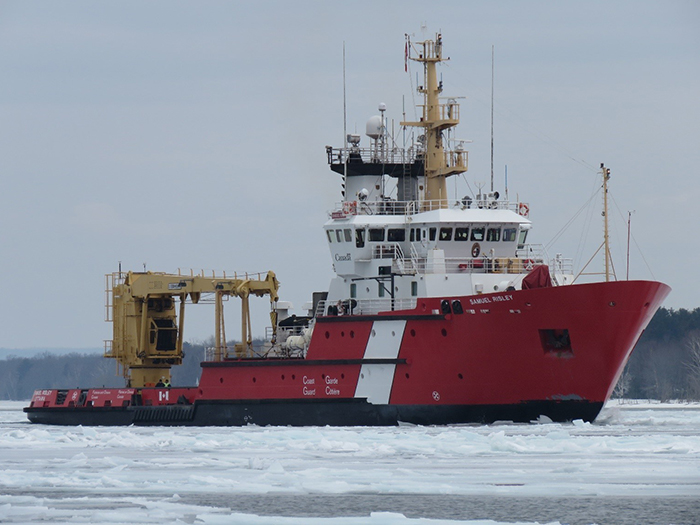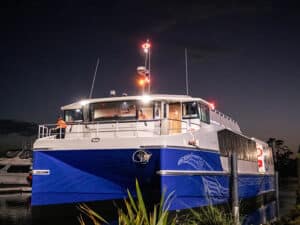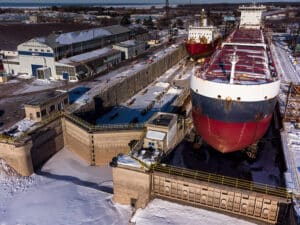
Canadian Coast Guard starts Great Lakes icebreaking season
Written by Marine Log Staff
The CCGS Samuel Risley performs icebreaking duties on the St. Marys River, Ontario in March 2020. [CNW Group/Canadian Coast Guard]
The Canadian Coast Guard’s annual icebreaking season on the Great Lakes, which provides assistance to the shipping industry, is underway.
Working in partnership with the United States Coast Guard (USCG) District 9, the Canadian Coast Guard has two icebreakers assigned to the Great Lakes for the entire winter season: CCGS Griffon and CCGS Samuel Risley. These vessels are supported as required by additional Coast Guard vessels during the spring icebreaking season.
This icebreaking season is different than usual due to the COVID-19 pandemic, and the Canadian Coast Guard is working closely with organizations and governments, industry, and other partners to make decisions based on the best advice and guidance available from federal, provincial, and municipal health authorities. The agency continues to maintain normal levels of operation during the COVID-19 pandemic, while following strict National Standard Operating Procedures to prevent the spread of the virus. This includes extra sanitation practices for all Coast Guard crew, such as frequent hand-washing, appropriate personal protective equipment (PPE), and enhanced cleaning protocols onboard vessels.
Icebreaking requests are coordinated by the CCG Icebreaking Office in Montreal, along with the USCG. Daily operational conference calls are held between industry representatives and Coast Guard officials, who provide updates from both countries about ice extent, concentration, and thickness. Ice condition updates are provided by Environment and Climate Change Canada, and also gathered from ice reconnaissance flights, using both Canadian and United States Coast Guard helicopters.
Marine Communications and Traffic Services in Sarnia and Prescott, Ontario, are in contact with mariners 24-hours-a-day providing information, managing marine traffic, and responding to calls for assistance. Winter maritime search and rescue operations are coordinated by the Joint Rescue Coordination Centre in Trenton, Ontari, Canadian Coast Guard icebreakers and other vessels may be called upon to help. Aircraft from Canada’s Department of National Defence and USCG are also involved in maritime search and rescue operations, as necessary.
In addition to icebreaking for the shipping industry, both Coast Guards work to prevent the formation of ice jams and flooding in communities. Problems occur when ice accumulates and blocks the flow of a river. That obstruction, known as an ice jam or ice plug, can cause flooding as water builds up and overflows the banks. Canadian Coast Guard ships are also at the ready to respond to environmental incidents or other urgent or humanitarian emergencies.
All ice surface users should plan their ice activities carefully, use caution on the ice, and avoid shipping lanes and icebreaking operations. Broken and fragmented ice tracks and ridging left behind by passing icebreakers or commercial vessels may not freeze over immediately. This can result in hazardous conditions for ice users. In addition, newly fallen snow will obscure ship tracks. Unsafe ice conditions can persist long after icebreakers have left the area.
Although the St. Lawrence Seaway, Welland Canal and Sault Ste. Marie Locks are closed during the winter months, shipping is still active on the Great Lakes and connecting waterways, including Lake Erie, Detroit River, Lake St. Clair, St. Clair River, Lake Huron, St. Marys River, and Georgian Bay.
- In the 2019-2020, in Central Region and the Great Lakes, the Canadian Coast Guard responded to 80 requests for icebreaking.
- In the 2019-2020, both Coast Guards directly assisted 58 ship transits on the Great Lakes.
- Between December 21, 2019 and April 4, 2020 (last day of icebreaking), CCGS Griffon and CCGS Samuel Risley traveled 2,224 nautical miles (4,119 kilometers) escorting commercial vessels through the ice, opening shipping routes and breaking out ports throughout the Great Lakes.




